
Hyperspectral Imaging Systems Market Size, Share & Trends Analysis Report By Application (Military, Remote Sensing), By Product (Camera, Accessories), By Technology (Push Broom, Snapshot), By Region, And Segment Forecasts, 2024 - 2030
- Report ID: GVR-2-68038-788-9
- Number of Report Pages: 110
- Format: PDF, Horizon Databook
- Historical Range: 2018 - 2023
- Forecast Period: 2024 - 2030
- Industry: Healthcare
Market Size & Trends
The global hyperspectral imaging systems market size was estimated at USD 14.13 billion in 2023 and is expected to grow at a compound annual growth rate (CAGR) of 10.7% from 2024 to 2030. The rising adoption of hyperspectral imagery systems in various sectors, such as R&D, healthcare, defense, food industry, night vision, and remote sensing, is anticipated to create high demand in the market. In addition, technological advancements, such as sensor design, high spectral resolution, high spatial resolution, and compact & lightweight devices, are anticipated to further boost product adoption. For instance, Pixxel launched its third hyperspectral imaging satellite, which was mounted on the Polar Satellite Launch Vehicle (PSLV) in November 2022.
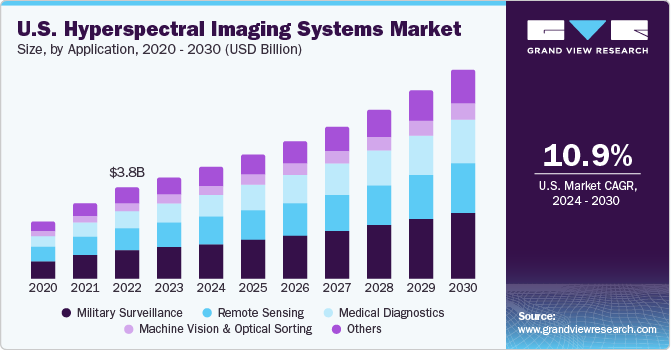
Hyperspectral imaging systems characterization involves assessing various aspects of their performance, capabilities, and specifications. This process typically includes spectral range, spectral resolution, temporal resolution, and many other factors. In comparison to traditional imaging and detection methods, hyperspectral imaging enhances sensitivity and differencing capability by integrating digital imaging with spectroscopy. The growing adoption of this technology is primarily attributed to its clarity and precision. Moreover, hyperspectral imaging devices offer several key benefits, including the ability to analyze spectral data at each point without prior knowledge. Furthermore, it provides comprehensive information for image analysis and processing. Owing to these advantages, this technology is attracting investments from many companies. However, high hyperspectral imaging system prices and lack of standardization and interoperability of this system may hinder market growth.
The growing application scope of hyperspectral imaging, such as the detection of rock minerals, the diagnosis of plant diseases in crops, diagnostic imaging, and the detection of foreign toxins in food processing are expected to boost its adoption. In addition, the applications of hyperspectral imaging are particularly increasing in the field of disease diagnosis and image-guided surgeries. The market is anticipated to grow at a significant rate, as hyperspectral imaging offers strong potential for disease screening, detection, and diagnosis due to its ability to recognize biochemical modifications brought on by the development of diseases, such as changes in cancer cell metabolism.
In January 2023, Imec demonstrated a system that combines a Visible and Near Infrared (VIS-NIR) spectral camera with high-resolution RGB imaging for data acquisition at video rate. The camera offers three sensors, which are integrated into a single housing. The camera is also equipped with a standard F-mount lens. This is expected to help users opt for a suitable sensor and compare the pros and cons of different spectral resolutions and ranges without needing to own numerous gadgets. The camera can provide support in uncontrollably dynamic scenarios including medical situations such as image-assisted surgeries.
Market Concentration & Characteristics
The market is growing due to the broad application scope of products across diverse fields, such as healthcare, agriculture, defense, aerospace, mining, and others. These systems can conduct detailed spectral analysis across a broad spectrum of wavelengths, allowing them to deliver valuable insights and solutions across various applications. In healthcare, hyperspectral imaging enables precise diagnosis, tissue characterization, and surgical guidance, thereby enhancing patient care and outcomes.
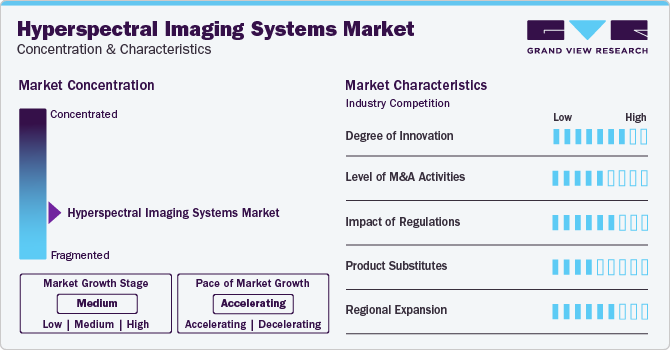
Market players are adopting different initiatives, such as product launches to expand their market reach. For instance, in January 2024, Specim, Spectral Imaging Ltd., announced the release of the Specim FX120, an advanced long-wave infrared hyperspectral camera featuring a full LWIR spectral range of 7.7 to 12.3 µm. This fast push-broom thermal hyperspectral camera is poised to redefine chemical imaging capabilities in challenging environments, operating seamlessly day and night.
Degree of Innovation: Hyperspectral imaging systems have undergone significant innovation, driven by remarkable technological advancements that have positioned them as leading technology across various fields, including healthcare, agriculture, defense, aerospace, mining, and others. Technological advancements, such as high spectral resolution, sensor design, high spatial resolution, and lightweight & compact devices, are expected to boost the adoption of hyperspectral imaging systems.
Level of M&A Activities: Manufacturers are increasingly engaging in integration through merger and acquisition activities. This strategic approach aims to augment technological capabilities, broaden market reach, and ensure competitiveness in the rapidly evolving healthcare landscape. For instance, in January 2024, Headwall Photonics acquired inno-spec GmbH, based in Nuremberg, Germany. Inno-spec GmbH is a renowned manufacturer of industrial hyperspectral imaging systems utilized in high-volume recycling, industrial sorting, and quality testing applications.
Impact of Regulations: Regulations play a crucial role in shaping the development, manufacturing, and commercialization of hyperspectral imaging systems, particularly in fields, such as agriculture, healthcare, and environmental monitoring. In agriculture, regulations may govern the use of hyperspectral imaging for crop monitoring, pesticide application, and soil analysis to ensure compliance with safety and environmental standards.
Product Substitutes: The presence of product substitutes for hyperspectral imaging cameras, such as the multispectral imaging systems and Fourier transform infrared (FTIR) spectroscopy, offers end-users alternatives to consider when making their imaging investments. While hyperspectral imaging cameras help capture detailed spectral information across a broad range of wavelengths, the availability of substitutes provides flexibility and choice to meet specific application needs and budget constraints.
Regional Expansion: The geographical reach of hyperspectral imaging systems has been expanding at a moderate to high level, primarily driven by increased adoption in developed economies, such as the U.S. and Japan. However, in underdeveloped or developing economies, their adoption is relatively low due to factors, such as limited access and inadequate regulations.
Product Insights
The camera segment held the largest market share of over 71.8% in 2023 and is expected to grow at the fastest CAGR from 2024 to 2030. Technological advancements, such as high-speed and low-cost circuits, advanced manufacturing technologies, and novel signal-processing methods in sensor development, have contributed to the segment growth. Factors, such as the quality, economic efficiency, and reliability of technical products, are anticipated to contribute to hyperspectral camera marketgrowth.
A hyperspectral camera acquires light intensity for a wide range of spectral bands. With this feature, every pixel in the image has a continuous spectrum, which can be used for the identification of objects with precision and detail. In addition, the availability of low-cost cameras and widening computing power are projected to boost the adoption of these products.
Technology Insights
The snapshot segment held the largest market share in 2023 and is expected to grow at a significant rate over the forecast period owing to increasing demand for high-resolution and real-time spectral data. Snapshot spectral sensors utilize optical designs that vary significantly from standard forms, and this technology does not require scanning in the spatial or spectral dimensions, such as push broom.
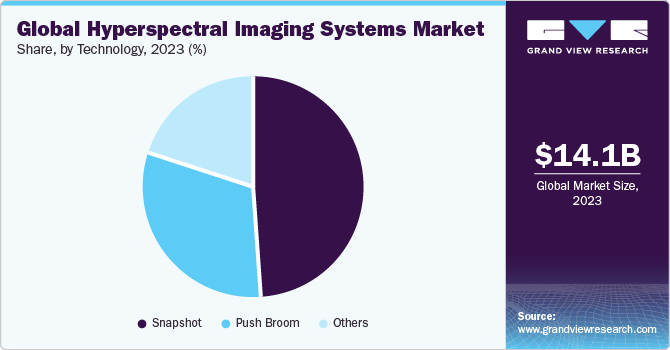
The push broom sensors segment held a considerable market share in 2023. Push broom sensors are mounted on moving platforms, such as aircraft or satellites, and scan the scene line by line, creating a continuous image of the spectral information. For instance, BaySpec’s OCI-F Hyperspectral Imager is a compact ‘true push-broom technology. The HSI push broom market is expected to grow significantly over the forecast period, due to the increasing demand for remote sensing, environmental monitoring, mineral exploration, and other fields that require detailed and accurate data.
Application Insights
The military segment dominated the market with a share of over 31.7% in 2023 owing to the advancements in data management, along with component fabrication techniques. Hyperspectral imaging has a wide range of military applications in the domains of tracking and identification of personnel or other objects. Better accuracy and consistency compared to other conventional imaging techniques are contributing to segment growth. Medical diagnostics is expected to become the fastest-growing segment with a CAGR of 11.6% from 2024 to 2030. Hyperspectral imaging offers a diagnosis of issues related to tissue morphology, structure, and physiology.
During the progression of a disease, the fluorescence, scattering, and absorption of the tissue change. Hence, tissue imaging techniques create a major scope of application in the diagnosis of tissue pathology. Furthermore, ophthalmology, injury analysis, procedures involving the digestive system, fluorescence microscopy, biology of cells, and cardiovascular systems all make extensive use of hyperspectral imaging techniques. The high precision and clarity of the hyperspectral imaging technology and ongoing innovation and technological advancements are expected to lead to growth opportunities for the medical diagnostics segment.
Regional Insights
North America held the largest market share of over 30.0% in 2023 owing to technologically advanced healthcare infrastructure, increased defense expenditure, adoption of novel technologies, and the presence of key players in the region. In addition, improved funding for R&D has boosted research activities in the region. As North America continues to drive innovation in hyperspectral imaging, the technology's versatility and rising application scope are poised to play a pivotal role in shaping the future of imaging technologies across the region.
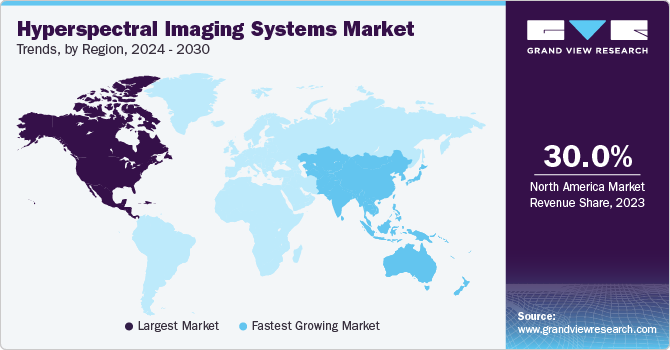
U.S. Hyperspectral Imaging Systems Market Trends
The U.S. market is expected to grow over the forecast period due to rising defense spending and a wide application scope of hyperspectral imaging systems.According to the Office of Management and Budget, the U.S. expended USD 766 billion on national defense in FY 2022, which amounted to 12% of federal spending. Lawmakers' allocation of significant funds toward defense highlights their prioritization of national security in their budget. The U.S. allocates a greater portion of its budget to defense to its economic size than any other member of the G7.
Europe Hyperspectral Imaging Systems Market Trends
The increasing adoption of hyperspectral imaging across various fields, such as chemical, pharmaceutical, medical diagnostics, food, agricultural, aerospace, and defense industries, is projected to drive growth in Europe. Technological advancements, including innovations in sensor design, high spectral and spatial resolutions, compactness, seamless integration with software, and the development of lightweight devices, are anticipated to propel market expansion. For instance, in November 2020, Imec and XIMEA launched a hyperspectral camera solution that meets the high requirements for machine vision applications.
UK Hyperspectral Imaging Systems Market Trends
The UK market is expected to grow at the fastest rate from 2024 to 2030 owing to technological advancements, particularly in sensor technologies and data processing techniques. Furthermore, the rising defense and healthcare spending in the UK is expected to fuel market growth. For instance, in 2021-2022, the UK spent nearly USD 57.97 billion on defense.
France Hyperspectral Imaging Systems Market Trends
The France market is expected to grow significantly over the forecast period due to the need for efficient and advanced technologies in environmental monitoring to address several issues, such as deforestation, biodiversity loss, and climate change.According to an article published by SpaceWatch.Global GmbH, Australia, and France collaborated in hyperspectral imaging for environmental monitoring.
Germany Hyperspectral Imaging Systems Market Trends
The presence of several key players and their strategic initiatives in the region are expected to fuel the regional market growth. For instance, in January 2024, Headwall Photonics acquired inno-spec GmbH, which is a leading manufacturer of industrial hyperspectral imaging systems used for quality testing.
Asia Pacific Hyperspectral Imaging Systems Market Trends
The market in Asia Pacific is estimated to witness the fastest CAGR from 2024 to 2030 due to the rising demand for hyperspectral imaging in research activities, remote sensing, farming, and mining explorations. Precision farming practices, facilitated by hyperspectral technology, enable farmers to monitor crop health, identify diseases, and optimize resource utilization. Asia Pacific stands out as the largest and most varied agricultural market globally, boasting a diverse range of climates, farmland types, and agricultural production methods.
China Hyperspectral Imaging Systems Market Trends
In 2023, China dominated the Asia Pacific regional market by capturing the largest share. This was primarily attributed to a range of initiatives undertaken within the country. For instance, in January 2024, the China National Space Administration (CNSA) declared the official initiation of activities for its newest Earth observation resource, the Gaofen 5 01A hyperspectral remote-sensing satellite, which was launched in December 2022, marking a significant stride in China's hyperspectral imaging systems sector.
Japan Hyperspectral Imaging Systems Market Trends
Japan is projected to experience the fastest CAGR from 2024 to 2030. This growth can be attributed to the country's strong focus on technological innovation and R&D, providing an ideal environment for the advancement of hyperspectral imaging systems technology. For instance, in January 2023, Panasonic, a Japan-based company, introduced a hyperspectral imaging systems technology employing compressed sensing technology in medical care and space exploration.
Latin America Hyperspectral Imaging Systems Market Trends
Latin America is anticipated to undergo moderate growth throughout the forecast period driven by several factors, including increasing demand for hyperspectral imaging technology within the healthcare sector, rising incidence of cancer, growing emphasis on R&D, adoption of advanced healthcare technologies, and supportive government initiatives.
MEA Hyperspectral Imaging Systems Market Trends
Middle East & Africa is anticipated to experience moderate growth during the forecast period owing to the increased focus of countries like Saudi Arabia and South Africa toward enhancing their military and healthcare sectors.
Key Hyperspectral Imaging Systems Company Insights
The key players operating in the hyperspectral imaging systems market are working to improve their product offerings by upgrading their products, leveraging important cooperative drives, as well as considering acquisitions and government approvals to increase their client base and get a larger part of the market share. For instance, In November 2023, Specim, Spectral Imaging Ltd. announced the launch of the upgraded Specim FX50 Middle-wave Infrared (MWIR) hyperspectral camera. The Specim FX50 is the first and only push-broom hyperspectral camera covering the full MWIR spectral range of 2.7 - 5.3 μm. This enhanced version marks a significant milestone for Specim and its customers. The initial release of the camera occurred in 2019.
Key Hyperspectral Imaging Systems Companies:
The following are the leading companies in the hyperspectral imaging systems market. These companies collectively hold the largest market share and dictate industry trends. Financials, strategy maps & products of these hyperspectral imaging systems companies are analyzed to map the supply network.
- Corning Inc.
- Specim
- Spectral Imaging Ltd.
- Resonon Inc.
- Headwall Photonics
- Telops
- Norsk Elektro Optikk
- Surface Optics Corporation
- BaySpec, Inc.
- HAIP Solutions GmbH
- XIMEA GmbH
- imec
Recent Developments
-
In January 2024, Specim, Spectral Imaging Ltd. entered into a partnership with GEONA hyperspectral. Specim proudly endorses GEONA as its preferred standalone processing solution for the complete range of SPECIM airborne hyperspectral sensors
-
In April 2023, Headwall Photonics and K8 announced Aermatica3D srl as an authorized, official reseller of their remote sensing products in Italy. Leveraging Aermatica3D's engineering expertise, the company is capable of developing custom solutions tailored for companies, professional firms, and research institutes
-
In June 2022, Resonon Inc. announced the launch of its Pika IR-L and IR-L+ hyperspectral cameras (925 - 1700 nm). These instruments boast impressive spectral and spatial resolution, which, when combined with their compact size and lightweight, render them ideal for UAV-based remote sensing applications
Hyperspectral Imaging Systems Market Report Scope
|
Report Attribute |
Details |
|
Market size value in 2024 |
USD 15.59 billion |
|
Revenue forecast in 2030 |
USD 28.63 billion |
|
Growth rate |
CAGR of 10.7% from 2024 to 2030 |
|
Actual period |
2018 - 2023 |
|
Forecast period |
2024 - 2030 |
|
Report updated |
February 2024 |
|
Quantitative units |
Revenue in USD million and CAGR from 2024 to 2030 |
|
Report coverage |
Revenue forecast, company ranking, competitive landscape, growth factors, and trends |
|
Segments covered |
Product, technology, application, region |
|
Regional scope |
North America; Europe; Asia Pacific; Latin America; MEA |
|
Country scope |
U.S.; Canada; UK; Germany; France; Italy; Spain; Denmark; Sweden; Norway; Japan; China; India; Australia; Thailand; South Korea; Brazil; Mexico; Argentina; South Africa; Saudi Arabia; UAE; Kuwait |
|
Key companies profiled |
Corning Inc.; Specim; Spectral Imaging Ltd.; Resonon Inc.; Headwall Photonics; Telops; Norsk Elektro Optikk; Surface Optics Corp.; BaySpec, Inc.; HAIP Solutions GmbH; XIMEA GmbH; imec |
|
Customization scope |
Free report customization (equivalent up to 8 analyst’s working days) with purchase. Addition or alteration to country, regional & segment scope |
|
Pricing and purchase options |
Avail customized purchase options to meet your exact research needs. Explore purchase options |
Global Hyperspectral Imaging Systems Market Report Segmentation
This report forecasts revenue growth at global, regional, and country levels and provides an analysis of the latest trends in each of the sub-segments from 2018 to 2030. For this study, Grand View Research has segmented the global hyperspectral imaging systems market report on the basis of product, technology, application, and region:
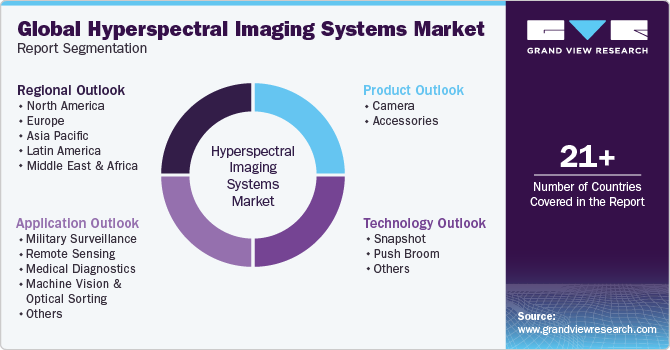
-
Product Outlook (Revenue, USD Million, 2018 - 2030)
-
Camera
-
Accessories
-
-
Technology Outlook (Revenue, USD Million, 2018 - 2030)
-
Snapshot
-
Push Broom
-
Others
-
-
Application Outlook (Revenue, USD Million, 2018 - 2030)
-
Military Surveillance
-
Remote Sensing
-
Medical Diagnostics
-
Machine Vision & Optical Sorting
-
Others
-
-
Regional Outlook (Revenue, USD Million, 2018 - 2030)
-
North America
-
U.S.
-
Canada
-
-
Europe
-
UK
-
Germany
-
France
-
Italy
-
Spain
-
Denmark
-
Sweden
-
Norway
-
-
Asia Pacific
-
Japan
-
China
-
India
-
Australia
-
Thailand
-
South Korea
-
-
Latin America
-
Brazil
-
Mexico
-
Argentina
-
-
Middle East & Africa
-
South Africa
-
Saudi Arabia
-
UAE
-
Kuwait
-
-
Frequently Asked Questions About This Report
b. The global hyperspectral imaging systems market size was estimated at USD 14.13 billion in 2023 and is expected to reach USD 15.59 billion in 2024.
b. The global hyperspectral imaging systems market is expected to grow at a compound annual growth rate of 10.7% from 2024 to 2030 to reach USD 28.63 billion by 2030.
b. North America dominated the hyperspectral imaging systems market with a share of 34.7% in 2023. This is attributable to to technologically advanced healthcare infrastructure, increased defense expenditure, adoption of novel technologies, and the existence of several market players in the region.
b. Some key players operating in the hyperspectral imaging systems market include Corning Incorporated, Specim, Spectral Imaging Ltd, Resonon Inc., Headwall Photonics, Telops, Norsk Elektro Optikk, Surface Optics CorporationBaySpec, Inc., HAIP Solutions GmbH, XIMEA GmbH, imec.
b. Key factors that are driving the market growth include increasing application of hyperspectral imaging in various sectors, such as research and development, healthcare, defense, food industry, night vision, and remote sensing.
We are committed towards customer satisfaction, and quality service.
"The quality of research they have done for us has been excellent."




